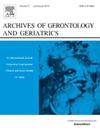Global, regional and national burden of knee osteoarthritis 1990–2021: A systematic analysis of the Global Burden of Disease study 2021
IF 3.5
3区 医学
Q2 GERIATRICS & GERONTOLOGY
引用次数: 0
Abstract
Objective
The systematic analysis aimed to assess the levels and trends of knee osteoarthritis (KOA) in 204 countries and territories from 1990 to 2021.
Methods
We analyzed the data on the Global Burden of Diseases 2021 and reported the KOA burden and the trends from 1990–2021 by age-standardized incidence rate (ASIR), age-standardized prevalence rate (ASPR) and age-standardized disability-adjusted life years (DALYs) rate (ASDAR) with 95 % uncertainty intervals (UIs). All estimates were presented as counts and age-standardized rates per 100,000 people, calculating the estimating average annual percent change (EAPCs).
Results
From 1990 to 2021, the KOA burden still showed an increasing trend globally, faster in females than males; the 35–39 years population has faster KOA symptoms, and 45–49 years have faster prevalence and DALYs. The high-middle SDI regions are experiencing the fastest increase. East Asia has the fastest growth, and North America has shown a stable trend with no change. The top 9 fastest growing countries and territories were Oman, Equatorial Guinea, Thailand, Saudi Arabia, Sudan, China, Taiwan (Province of China), Maldives, and Pakistan. By 2050 of prediction, there may be an obvious decreasing trend in KOA burden. Frontier analysis indicates the presence of unrealized opportunities to close the KOA burden gap in most countries and territories. Decomposition analyses indicate that population growth accounted for >70 % of the global KOA burden. SDI level was positively associated with KOA burden increasing, and ASIR or HDI was not associated with the burden EAPC.
Conclusion
KOA is still a major global health challenge. Although there is variation between countries and regions, most countries' KOA burden is increasing, especially among females and young adults.
1990-2021年全球、地区和国家膝关节骨关节炎负担:2021年全球疾病负担研究的系统分析
目的对1990年至2021年204个国家和地区的膝骨关节炎(KOA)水平和趋势进行系统分析。方法对全球疾病负担(Global Burden of Diseases 2021)数据进行分析,以年龄标准化发病率(ASIR)、年龄标准化患病率(ASPR)和年龄标准化残疾调整生命年(DALYs)率(ASDAR)为指标,以95%的不确定性区间(UIs)报告1990-2021年KOA负担及其趋势。所有的估计都以每10万人的计数和年龄标准化率的形式呈现,计算估计的平均年变化百分比(EAPCs)。结果1990 - 2021年,全球KOA负担仍呈上升趋势,女性增长快于男性;35-39岁人群KOA症状更快,45-49岁人群KOA患病率和DALYs更快。中高SDI区域增长最快。东亚增长最快,北美呈现稳定趋势,没有变化。预计到2050年,KOA负担可能有明显的下降趋势。前沿分析表明,在大多数国家和地区存在缩小KOA负担差距的未实现机会。分解分析表明,人口增长占全球KOA负担的70%。SDI水平与KOA负担加重呈正相关,而ASIR或HDI与负担性EAPC无关。结论koa仍是全球卫生领域面临的重大挑战。虽然国家和区域之间存在差异,但大多数国家的KOA负担正在增加,特别是在女性和年轻人中。
本文章由计算机程序翻译,如有差异,请以英文原文为准。
求助全文
约1分钟内获得全文
求助全文
来源期刊
CiteScore
7.30
自引率
5.00%
发文量
198
审稿时长
16 days
期刊介绍:
Archives of Gerontology and Geriatrics provides a medium for the publication of papers from the fields of experimental gerontology and clinical and social geriatrics. The principal aim of the journal is to facilitate the exchange of information between specialists in these three fields of gerontological research. Experimental papers dealing with the basic mechanisms of aging at molecular, cellular, tissue or organ levels will be published.
Clinical papers will be accepted if they provide sufficiently new information or are of fundamental importance for the knowledge of human aging. Purely descriptive clinical papers will be accepted only if the results permit further interpretation. Papers dealing with anti-aging pharmacological preparations in humans are welcome. Papers on the social aspects of geriatrics will be accepted if they are of general interest regarding the epidemiology of aging and the efficiency and working methods of the social organizations for the health care of the elderly.

 求助内容:
求助内容: 应助结果提醒方式:
应助结果提醒方式:


